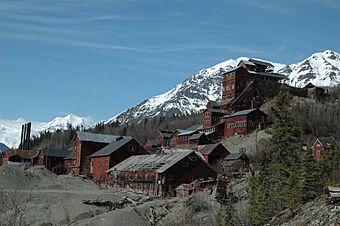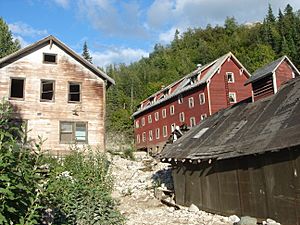Kennecott, Alaska facts for kids
|
Kennecott Mines
|
|

The 14-story Kennicott Concentration Mill (to the right). The mines are 5 miles up in the mountains to the east/northeast. Also pictured: foreground (left to right): power plant, machine shop, flotation plant, ammonia leaching plant (world's first); in the trees to the right - general manager's office (the log cabin portion was the first building built in Kennicott)
|
|
| Location | East of Kennicott Glacier, about 6.5 miles (10.5 km) north of McCarthy |
|---|---|
| Nearest city | McCarthy, Alaska |
| Area | 7,700 acres (3,100 ha) |
| Built | 1908-1911 |
| Architect | Kennecott Mines Company |
| NRHP reference No. | 78003420 |
Quick facts for kids Significant dates |
|
| Added to NRHP | July 12, 1978 |
| Designated NHLD | June 23, 1986 |
Kennecott, also called Kennicott, is an old mining town in Alaska. It was once a very busy place where people dug for copper. The town is located next to the Kennicott Glacier, inside a huge natural area called Wrangell-St. Elias National Park and Preserve.
Today, Kennecott is an important National Historic Landmark District. This means it's a special place protected by the National Park Service. It helps us remember the history of mining in Alaska.
Contents
History of Kennecott Mines
How Copper Was Discovered
In the summer of 1900, two men named Jack Smith and Clarence Warner were looking for valuable minerals. They were called prospectors. They saw a green patch high up on a mountain. This green color came from a mineral called malachite, which often means copper is nearby. They found a lot of copper ore, especially a type called chalcocite. This discovery became known as the Bonanza claim.
Soon after, a geologist named Arthur Spencer from the U.S. Geological Survey also found copper in the same spot. However, he was too late to claim the land for himself.
Building the Mining Company
A young mining engineer named Stephen Birch heard about the copper discovery. He had money from wealthy families, like the Havemeyers, to invest in new projects. Birch spent a lot of time in Alaska, mapping the area and taking samples. He confirmed that the Bonanza mine had the richest copper in the world at that time.
By 1905, Birch had secured his claims. He then looked for more money to develop the mines. In 1906, he teamed up with powerful businessmen like Daniel Guggenheim and J.P. Morgan. This group was called the Alaska Syndicate. They invested over $30 million to build a railway, a steamship line, and to develop the mines.
Political Challenges and Growth
Developing the mines and building the railway caused some political arguments. People who wanted to protect nature, called conservationists, disagreed with those who had a financial interest in the copper. These discussions even reached U.S. President Theodore Roosevelt.
In 1915, the Alaska Syndicate created a new company called the Kennecott Copper Corporation. They transferred their mining assets to this new company. Stephen Birch became the main manager for the operations in Alaska.
Naming the Mines
The Kennecott Mines were named after the Kennicott Glacier nearby. A geologist named Oscar Rohn had named the glacier after Robert Kennicott in 1899. However, a mistake was made when the name was written down. An "e" was used instead of an "i", supposedly by Stephen Birch himself.
The Mines and Transporting Ore
Kennecott had five main mines: Bonanza, Jumbo, Mother Lode, Erie, and Glacier.
- The Bonanza and Jumbo mines were on Bonanza Ridge, about 3 miles (4.8 km) from Kennecott.
- The Mother Lode mine was on the other side of the ridge.
- The Erie mine was perched on a cliff overlooking Root Glacier, about 3.7 miles (6 km) from Kennecott.
- Glacier was an open-pit mine, only worked in the summer.
Tunnels connected the Bonanza, Jumbo, Mother Lode, and Erie mines. The copper ore was brought down to Kennecott using special cable cars called tramways. From Kennecott, the ore was put into 140-pound (63.5 kg) sacks. These sacks were then loaded onto trains. The trains traveled 196 miles (315 km) on the Copper River and Northwestern Railway (CRNW) to Cordova.
The first train shipment of ore happened in 1911. Before the railway was finished, a steamship carried the ore. The first shipments of ore were very rich, containing 72% copper and 18 ounces of silver per ton. In 1916, the mines had their best year, producing copper worth $32.4 million.
The Mines Close Down
By 1925, geologists at Kennecott realized that the richest copper deposits were running out. The Glacier Mine closed in 1929. The Mother Lode mine closed in July 1938. The last three mines—Erie, Jumbo, and Bonanza—closed in September 1938. The very last train left Kennecott on November 10, 1938, turning the town into a ghost town.
From 1909 to 1938, the Kennecott mines produced over 1.183 billion pounds of copper. The company made over $200 million in sales and more than $100 million in profit.
Kennecott Becomes a Historic Site
After the mines closed, Kennecott was mostly empty. Only a family of watchmen stayed until about 1952. In the late 1960s, there was an idea to reprocess the leftover mining waste, but it was too expensive. At one point, the company that owned the land wanted to destroy the town to avoid responsibility for accidents. Luckily, they didn't finish the job, and most of the buildings remained standing.
In 1938, a man named Ernest Gruening suggested that Kennecott should become a National Park. This idea didn't happen right away. However, on December 2, 1980, the Wrangell-St. Elias National Park and Preserve was created, which includes Kennecott.
Today, many of the old mill buildings and other structures are being repaired and preserved.
Kennecott's Population
Kennecott was first counted in the 1920 U.S. Census as a small village.
- In 1920, 494 people lived there.
- By 1930, the population dropped to 217.
- In 1940, only 5 people remained.
After 1940, Kennecott was abandoned and no longer counted separately. It is now part of the nearby community of McCarthy.
| Historical population | |||
|---|---|---|---|
| Census | Pop. | %± | |
| 1920 | 494 | — | |
| 1930 | 217 | −56.1% | |
| 1940 | 5 | −97.7% | |
| U.S. Decennial Census | |||
How Copper Was Processed
The Concentration Mill
Getting copper from the ore was a multi-step process designed to be very efficient. The main building for this was the 14-story mill. It was built between 1909 and 1923.
Ore arrived at the mill by aerial tramways.
- High-grade ore (about 60% copper) was crushed and sent directly to the bottom of the mill. There, it was put into burlap sacks for shipping.
- Lower-grade ore needed more processing. It was crushed further, sorted by size, and then separated. Denser copper ore was separated from lighter waste rock using special machines called Hancock jigs and shaker tables.
Advanced Copper Extraction Methods
Even after the first separation, valuable copper was left in the waste material, called tailings.
- In 1915, an ammonia leaching plant was built. This plant used ammonia to dissolve the copper from the coarser tailings, while the limestone stayed solid. The ammonia-copper liquid was then heated. This made the ammonia evaporate, leaving behind copper oxide, which was 75% copper. This was also sacked for shipment.
- In 1923, a flotation plant was added to process very fine particles (less than 0.3 cm). These fines were mixed with water, oil, and special chemicals. Air was then bubbled through the mixture. The copper ore stuck to the air bubbles and floated to the top. This copper-rich foam was skimmed off, dried, and sacked.
Visiting Kennecott Today
A Popular Tourist Spot
In the 1980s, Kennecott became a popular place for tourists. People wanted to see the old mines and buildings. Even though the town itself was never repopulated, many people involved in tourism live in nearby McCarthy. In 1986, Kennecott was named a National Historic Landmark. The National Park Service bought much of the land in the Kennecott Mill Town in 1998.
Activities for Visitors
When you visit Kennecott, you can do many exciting things:
- Go glacier hiking.
- Try ice climbing.
- Take guided tours of the amazing 14-story abandoned mill.
- Hike to the old Bonanza, Jumbo, and Erie mines. These are long and challenging hikes. The hike to Erie Mine is especially difficult, with parts along cliffs. Local guides can help you with these hikes.
How to Get There
You can reach Kennecott in a few ways:
- By Air: McCarthy has a gravel runway where small planes can land.
- By Car: You can drive on the Edgerton Highway to the McCarthy Road. This is an unpaved gravel road. The McCarthy Road ends at the Kennicott River. You can walk across a footbridge to get to McCarthy. From McCarthy, it's about 4.5 miles (7.2 km) to Kennecott. Shuttles are available to take you the rest of the way.
Images for kids
-
Map of the Chitina River valley. "x" shows a copper prospect, and "+" shows a gold placer.
-
Geologic map of the Kennecott and Bonanza Mine area. "ng" is the Nikolai greenstone formation, "Trc" is the Chitistone limestone formation, while "Qrg" are rock glaciers.
-
Topographic map showing the location of the Erie, Jumbo, Mother Lode, Bonanza and Glacier Mines in relation to Kennecott. Notice the aerial tramways and tunnels.












